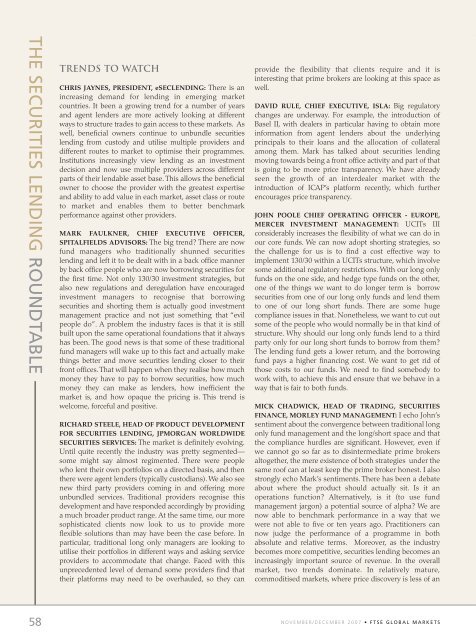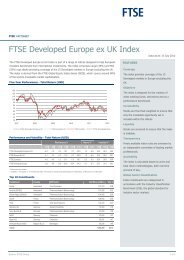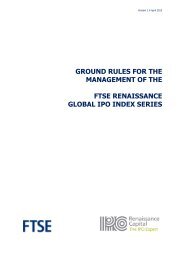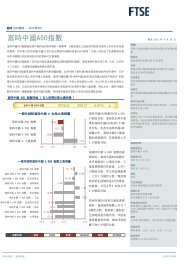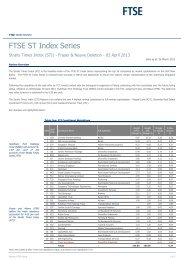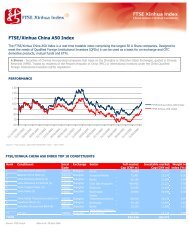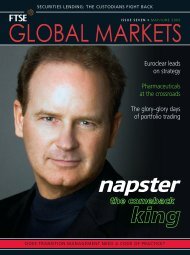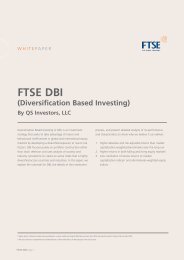Section 2 - FTSE
Section 2 - FTSE
Section 2 - FTSE
You also want an ePaper? Increase the reach of your titles
YUMPU automatically turns print PDFs into web optimized ePapers that Google loves.
THE SECURITIES LENDING ROUNDTABLE<br />
58<br />
TRENDS TO WATCH<br />
CHRIS JAYNES, PRESIDENT, eSECLENDING: There is an<br />
increasing demand for lending in emerging market<br />
countries. It been a growing trend for a number of years<br />
and agent lenders are more actively looking at different<br />
ways to structure trades to gain access to these markets. As<br />
well, beneficial owners continue to unbundle securities<br />
lending from custody and utilise multiple providers and<br />
different routes to market to optimise their programmes.<br />
Institutions increasingly view lending as an investment<br />
decision and now use multiple providers across different<br />
parts of their lendable asset base. This allows the beneficial<br />
owner to choose the provider with the greatest expertise<br />
and ability to add value in each market, asset class or route<br />
to market and enables them to better benchmark<br />
performance against other providers.<br />
MARK FAULKNER, CHIEF EXECUTIVE OFFICER,<br />
SPITALFIELDS ADVISORS: The big trend? There are now<br />
fund managers who traditionally shunned securities<br />
lending and left it to be dealt with in a back office manner<br />
by back office people who are now borrowing securities for<br />
the first time. Not only 130/30 investment strategies, but<br />
also new regulations and deregulation have encouraged<br />
investment managers to recognise that borrowing<br />
securities and shorting them is actually good investment<br />
management practice and not just something that “evil<br />
people do”. A problem the industry faces is that it is still<br />
built upon the same operational foundations that it always<br />
has been. The good news is that some of these traditional<br />
fund managers will wake up to this fact and actually make<br />
things better and move securities lending closer to their<br />
front offices.That will happen when they realise how much<br />
money they have to pay to borrow securities, how much<br />
money they can make as lenders, how inefficient the<br />
market is, and how opaque the pricing is. This trend is<br />
welcome, forceful and positive.<br />
RICHARD STEELE, HEAD OF PRODUCT DEVELOPMENT<br />
FOR SECURITIES LENDING, JPMORGAN WORLDWIDE<br />
SECURITIES SERVICES: The market is definitely evolving.<br />
Until quite recently the industry was pretty segmented—<br />
some might say almost regimented. There were people<br />
who lent their own portfolios on a directed basis, and then<br />
there were agent lenders (typically custodians). We also see<br />
new third party providers coming in and offering more<br />
unbundled services. Traditional providers recognise this<br />
development and have responded accordingly by providing<br />
a much broader product range. At the same time, our more<br />
sophisticated clients now look to us to provide more<br />
flexible solutions than may have been the case before. In<br />
particular, traditional long only managers are looking to<br />
utilise their portfolios in different ways and asking service<br />
providers to accommodate that change. Faced with this<br />
unprecedented level of demand some providers find that<br />
their platforms may need to be overhauled, so they can<br />
provide the flexibility that clients require and it is<br />
interesting that prime brokers are looking at this space as<br />
well.<br />
DAVID RULE, CHIEF EXECUTIVE, ISLA: Big regulatory<br />
changes are underway. For example, the introduction of<br />
Basel II, with dealers in particular having to obtain more<br />
information from agent lenders about the underlying<br />
principals to their loans and the allocation of collateral<br />
among them. Mark has talked about securities lending<br />
moving towards being a front office activity and part of that<br />
is going to be more price transparency. We have already<br />
seen the growth of an interdealer market with the<br />
introduction of ICAP’s platform recently, which further<br />
encourages price transparency.<br />
JOHN POOLE CHIEF OPERATING OFFICER - EUROPE,<br />
MERCER INVESTMENT MANAGEMENT: UCITs III<br />
considerably increases the flexibility of what we can do in<br />
our core funds. We can now adopt shorting strategies, so<br />
the challenge for us is to find a cost effective way to<br />
implement 130/30 within a UCITs structure, which involve<br />
some additional regulatory restrictions. With our long only<br />
funds on the one side, and hedge type funds on the other,<br />
one of the things we want to do longer term is borrow<br />
securities from one of our long only funds and lend them<br />
to one of our long short funds. There are some huge<br />
compliance issues in that. Nonetheless, we want to cut out<br />
some of the people who would normally be in that kind of<br />
structure. Why should our long only funds lend to a third<br />
party only for our long short funds to borrow from them?<br />
The lending fund gets a lower return, and the borrowing<br />
fund pays a higher financing cost. We want to get rid of<br />
those costs to our funds. We need to find somebody to<br />
work with, to achieve this and ensure that we behave in a<br />
way that is fair to both funds.<br />
MICK CHADWICK, HEAD OF TRADING, SECURITIES<br />
FINANCE, MORLEY FUND MANAGEMENT: I echo John’s<br />
sentiment about the convergence between traditional long<br />
only fund management and the long/short space and that<br />
the compliance hurdles are significant. However, even if<br />
we cannot go so far as to disintermediate prime brokers<br />
altogether, the mere existence of both strategies under the<br />
same roof can at least keep the prime broker honest. I also<br />
strongly echo Mark’s sentiments. There has been a debate<br />
about where the product should actually sit. Is it an<br />
operations function? Alternatively, is it (to use fund<br />
management jargon) a potential source of alpha? We are<br />
now able to benchmark performance in a way that we<br />
were not able to five or ten years ago. Practitioners can<br />
now judge the performance of a programme in both<br />
absolute and relative terms. Moreover, as the industry<br />
becomes more competitive, securities lending becomes an<br />
increasingly important source of revenue. In the overall<br />
market, two trends dominate. In relatively mature,<br />
commoditised markets, where price discovery is less of an<br />
NOVEMBER/DECEMBER 2007 • <strong>FTSE</strong> GLOBAL MARKETS


